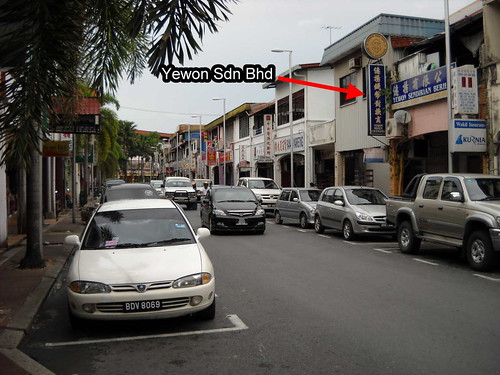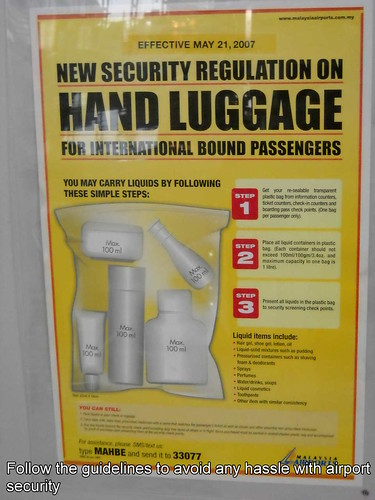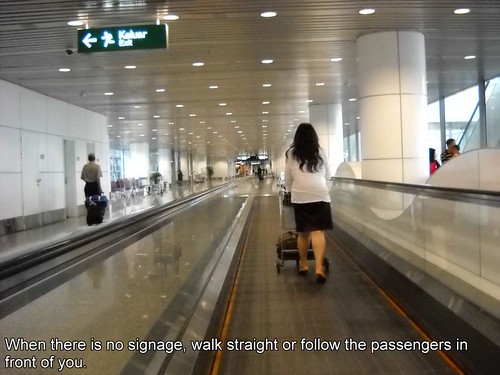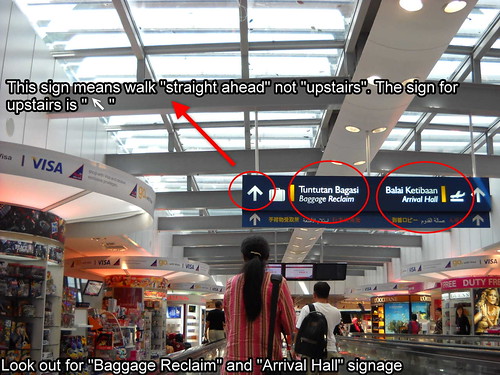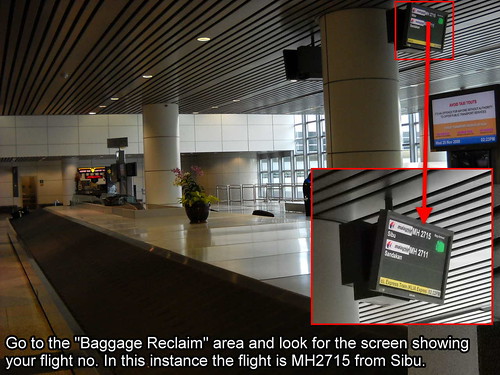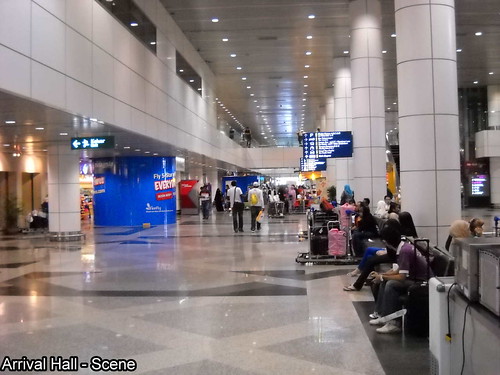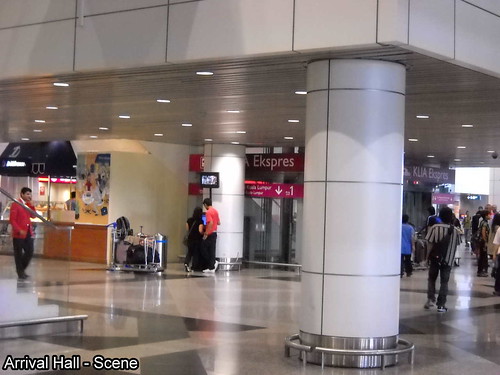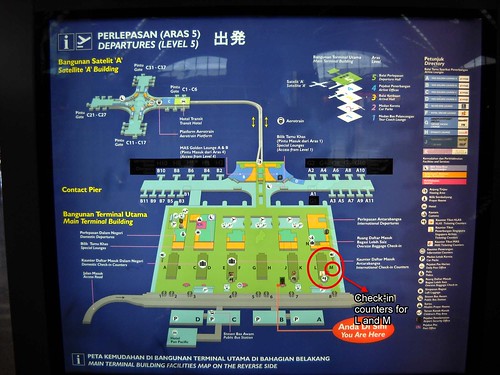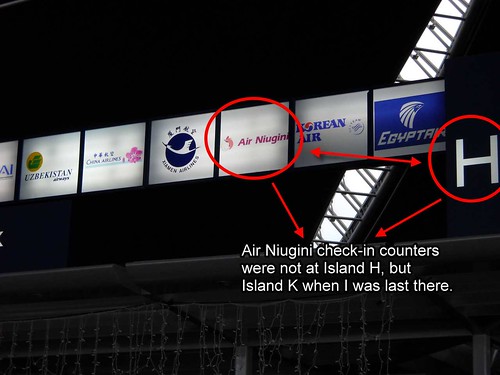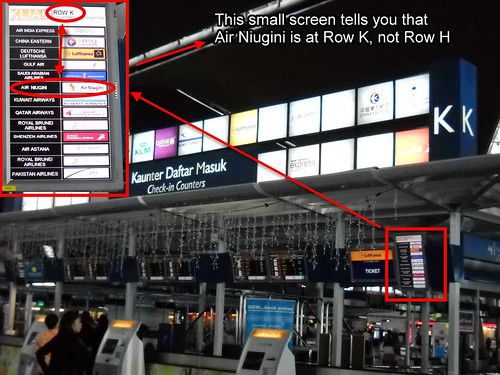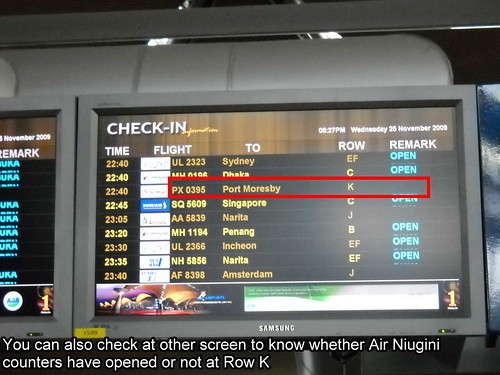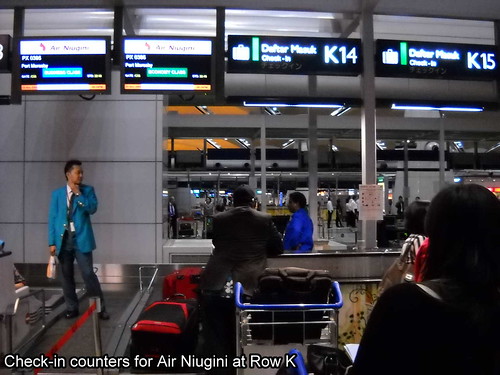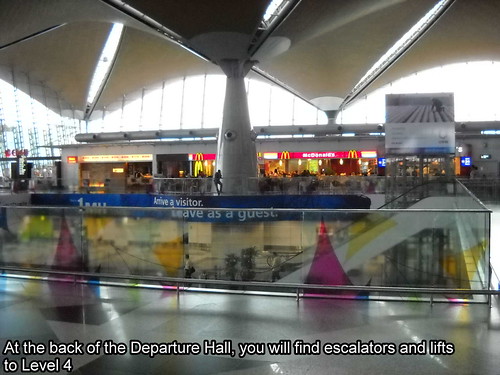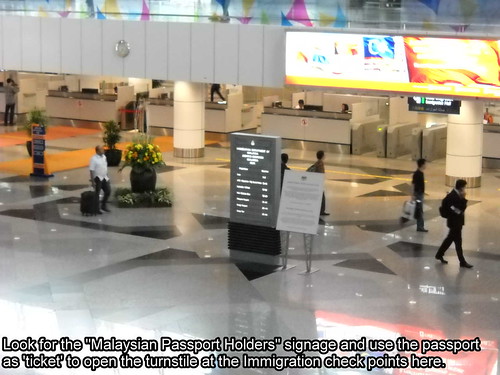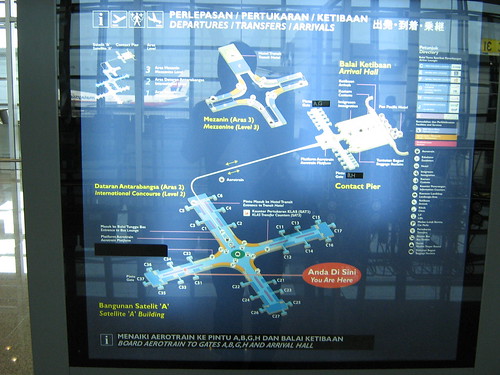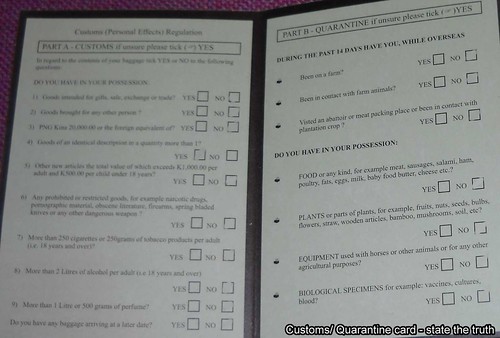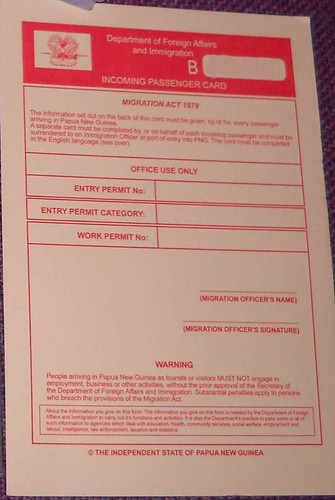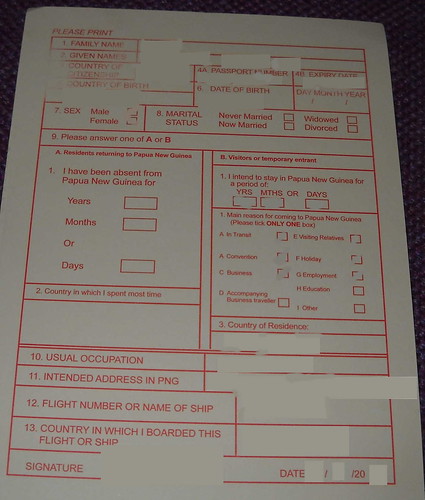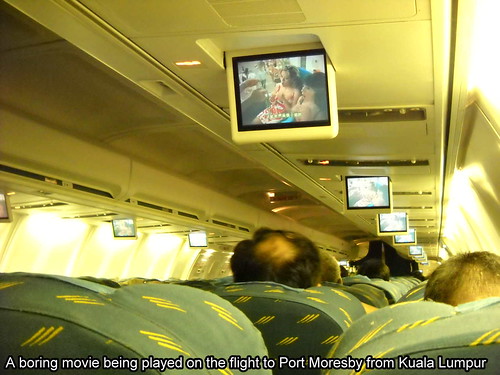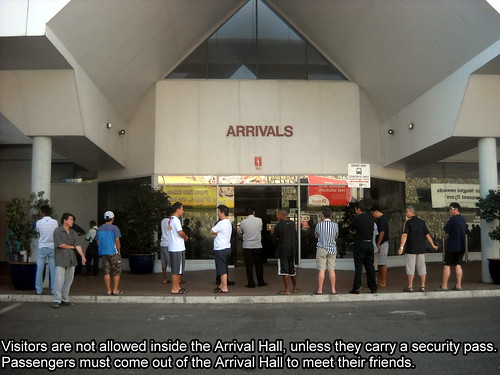During the course of my first year in Port Moresby, I realised that many new recruits, both Iban and Chinese Malaysians, to Papua New Guinea (PNG) have a fear of travelling unaccompanied. This is understandable since Asians are generally unadventurous. The main reason could be because of the fear of getting lost or looking lost.
In order to assist first time travellers, especially those who have never travelled outside Malaysia through Kuala Lumpur International Airport (KLIA), the following will serve as a simple guide and this was based on my own experience in November 2009. Time passes, and some of the information may no longer be accurate. Check for the latest updates to this information.
Readers are assumed to know how to get to KLIA from their hometowns.
All the pictures in this blog can be enlarged by clicking on them.
1. Before You Travel
In order to assist first time travellers, especially those who have never travelled outside Malaysia through Kuala Lumpur International Airport (KLIA), the following will serve as a simple guide and this was based on my own experience in November 2009. Time passes, and some of the information may no longer be accurate. Check for the latest updates to this information.
Readers are assumed to know how to get to KLIA from their hometowns.
All the pictures in this blog can be enlarged by clicking on them.
1. Before You Travel
Air Niugini Schedule
Beginning 6th November 2010, Air Niugini flies KUL-POM on Saturdays and SIN-POM on Mondays and Thursdays. This is the peak period prior to Christmas and soon after Chinese New Year. Towards the end of March 2011, Air Niugini is expected to revert to its old schedule of flying SIN-POM on Mondays and SIN-KUL-POM on Thursdays.
Money
Since Malaysian Ringgit (MYR) is not convertible to PNG Kina (PGK), carry US dollars (USD) or Australian dollars (AUD). In Sibu, you can convert MYR to USD at Yewon Sdn Bhd, which lies opposite Pathlab branch in the town. You can also convert MYR to USD at KLIA. USD200 should be sufficient for you.
Beginning 6th November 2010, Air Niugini flies KUL-POM on Saturdays and SIN-POM on Mondays and Thursdays. This is the peak period prior to Christmas and soon after Chinese New Year. Towards the end of March 2011, Air Niugini is expected to revert to its old schedule of flying SIN-POM on Mondays and SIN-KUL-POM on Thursdays.
Money
Since Malaysian Ringgit (MYR) is not convertible to PNG Kina (PGK), carry US dollars (USD) or Australian dollars (AUD). In Sibu, you can convert MYR to USD at Yewon Sdn Bhd, which lies opposite Pathlab branch in the town. You can also convert MYR to USD at KLIA. USD200 should be sufficient for you.
Address
Write down the address of your employer on a piece of paper and keep it safe and easily accessible. You need this to complete the Immigration Incoming Passenger Card later on.
Pen
You need a pen to complete the Incoming Passenger Card and Customs/ Quarantine Card before your arrival in PNG.
2. Baggage
Make sure you follow the instructions given in the guideline below. If you do not want any hassle with the airport security, then do not carry bottled water or any liquid in your hand-carry baggage.
In addition, travellers to PNG are also advised not to bring things which they do not wish to declare to PNG Customs. Please refer to paragraph 8.
Your check-in baggage allowance is 20 kg. If you do not wish to carry or lug your baggage around at KLIA, you should check in your baggage at Sibu Airport all the way to Port Moresby.
3. Arrival at KLIA
KLIA is big. Once you disembark from the plane, your immediate destination should be the "Baggage Reclaim" area or "Arrival Hall". As you walk along the corridor/ passageway, look out for the direction signage saying "Baggage Reclaim" or "Arrival Hall" hanging above you everywhere. The "Baggage Reclaim" area will always be next to the "Arrival Hall". Go to the "Baggage Reclaim" area first to pick up your baggage. If your baggage has been checked in all the way to POM, and you have nothing to pick up, go straight to the arrival hall.
Remember to follow the direction on the signage all the time and not the passengers in front of you all the time, because they may go shopping first before going to "Baggage Reclaim" or the arrival hall later on. Ask the fellow passengers around you, if lost, and there is nothing to be embarrassed.
4. Baggage Reclaim Area
At a large airport such as KLIA, the "Baggage Reclaim" area is very big, to cater for the large number of flights from around the world. Check your ticket for your flight no. and look for the display screen showing your flight no.
At a large airport such as KLIA, the "Baggage Reclaim" area is very big, to cater for the large number of flights from around the world. Check your ticket for your flight no. and look for the display screen showing your flight no.
Wait for your baggage to come around on the baggage conveyors. Once you have picked up your baggage, exit to the arrival hall.
5. Arrival Hall
The Arrival Hall is on Level 3 of the airport main terminal building (MTB). From the Arrival Hall, you can either take the lift or the escalator to the Departure Hall on Level 5.
5. Arrival Hall
The Arrival Hall is on Level 3 of the airport main terminal building (MTB). From the Arrival Hall, you can either take the lift or the escalator to the Departure Hall on Level 5.
6. Departure Hall
As a large international airport, KLIA check-in counters are arranged in clusters called Island, named alphabetically such as Island K, L, M, etc. They are also called Row K, L or M, etc. Each Island or Row caters to a number of airlines.
At the time I was there, Air Niugini was at Row K, not Row H if you were to look at the large signage hanging at Island H.
Rather, look at the smaller display screens to know where Air Niugini check-in counters are, i.e. at which Island or Row.
From the many display screens around the Departure Hall, you can check whether Air Niugini check-in counters have opened or not. Air Niugini flight carries the code PX, whereas for Malaysia Airlines, it is MH.
You can of course also refer to the big screen to know whether the check-in counters have opened or not, and at the same time to know the location of the check-in counters, i.e. at which Island or Row.
If you are used to scanning your check-in baggage before checking in the baggage, you do not have to do this at KLIA. In fact, you will not find such scanners at the departure hall. It is not necessary.
Please take note that Air Niugini check-in counters open very late, approximately 2 ½ hours from departure time.
At the back of the Departure Hall, you will find escalators and lifts going down to Level 4.
After you have obtained your boarding pass at the check-in counters, you will need to go down to Level 4 to board the aerotrain to Satellite 'A' Building for your international flight to Port Moresby. First, the policemen/ women manning the entrance to Level 4 will check your boarding pass and passport. After you are down at Level 4, look for the signage for Malaysian Passport Holders. You will then use the electronic passport as a 'ticket' to turn the turnstile to pass through Immigration. After that, you need to pass through the second police check where your baggage will be scanned and a body search conducted.
Now look at your boarding pass. Under "Pintu/ Gate" (i.e. the departure gate) in the following photo, you will find C33. Now, look at the signage hanging above you and find C33. When you see something like C1 - C37, you know you have found your direction. That is in fact the only direction. Follow the direction on the signage and you will finally arrive at the Contact Pier, i.e. the waiting area, for the aerotrain. Board the aerotrain.
The aerotrain will take you to Satellite 'A' Building.
7. Satellite 'A' Building
On disembarking at Satellite 'A' Building, you will find that the building is very large. Do not panic. You won't get lost. There are altogether 37 gates, numbered from C1 to C37, spread across four wings. Just look at the signage hanging above you and find the departure gate number that corresponds to the gate number written on your boarding pass. In this instance, it is C33.
At KLIA, you are not allowed to enter the departure gate until it is opened. You have to wait outside. When entering the departure gate, the police manning it will scan your baggage once more and conduct a second body check.
8. The Immigration Incoming Passenger Card and Customs/ Quarantine Card
Unlike Malaysia and most Asian countries, the Customs Department and Immigration Department in PNG are very stringent with their checking. It is like 100% checking of visitors and their baggage.
In the Immigration Incoming Passenger Card, ensure what you write does not contradict the terms and conditions of your entry permit/ visa or the laws. For example, if you are holding a business visa, do not say to the Immigration Officer that you are here to work for so and so or gives indications that you are working for someone. A person on business visa is not allowed to work. A business visa holder is only allowed to attend business meetings, board meetings, conferences, exploratory business visits or participate in business negotiation. If you are holding a working resident entry permit/ visa and is asked who your employer is, you should say the name of the company stated in your visa and no one else.
In the Customs/ Quarantine Card, declare the fact or do not bring the items which you are trying to avoid being taxed. The Customs officers here are very corrupted and they will find excuses to withhold your baggage/ items to extract a bribe from you. Do not give them the opportunity to solicit a bribe from you. If you have a pair of identical batteries, a new pair of socks, or a packet of sweets, declare them. Do not lie.
The following are a few examples which were told to me by employees who were victims of the Immigration/ Customs officers themselves or their friends:
Unlike Malaysia and most Asian countries, the Customs Department and Immigration Department in PNG are very stringent with their checking. It is like 100% checking of visitors and their baggage.
In the Immigration Incoming Passenger Card, ensure what you write does not contradict the terms and conditions of your entry permit/ visa or the laws. For example, if you are holding a business visa, do not say to the Immigration Officer that you are here to work for so and so or gives indications that you are working for someone. A person on business visa is not allowed to work. A business visa holder is only allowed to attend business meetings, board meetings, conferences, exploratory business visits or participate in business negotiation. If you are holding a working resident entry permit/ visa and is asked who your employer is, you should say the name of the company stated in your visa and no one else.
In the Customs/ Quarantine Card, declare the fact or do not bring the items which you are trying to avoid being taxed. The Customs officers here are very corrupted and they will find excuses to withhold your baggage/ items to extract a bribe from you. Do not give them the opportunity to solicit a bribe from you. If you have a pair of identical batteries, a new pair of socks, or a packet of sweets, declare them. Do not lie.
The following are a few examples which were told to me by employees who were victims of the Immigration/ Customs officers themselves or their friends:
- An old time employee was held by the Immigration. The reason for the detention was the address he wrote on the card indicated a different employer from the name of the employer in his working resident entry permit/ visa. For example, you work for a company called XYZ which is a subsidiary of ABC. Your entry permit/ visa states XYZ as the employer but in the Immigration card, you give ABC as the address. He was released with a PGK50 bribe. So make sure that you know what you write in the card.
- A baggage containing clothes of an Iban employee was withheld and the passport was not returned to him by a Custom Officer (not the Immigration Officer). The reason? He brought in too many pairs of clothes. The baggage and passport were returned to him only after a bribe of PGK100 was paid
- An employee brought a notebook PC from Sibu for a colleague in PNG. It was still in the original packaging. He did not declare it in the Customs card and he did not bring the receipt for the purchase of the notebook PC. Customs seized the notebook PC and refused to return it to him. His colleague, the owner of the notebook PC, was called to the airport to talk to the Customs officers. The final outcome was unknown. So, never bring in new items of high value unless you declare them and bring the receipt.
- A friend brought something into PNG from Malaysia for the company. The person who passed him the items forgot to give him the receipt. The value was just a few hundred Malaysian Ringgit and with the 10% General Sales Tax imposed, the payable tax would be less than PGK100. For the failure to produce the receipt, he was made to pay PGK250 in tax.
- Another colleague asked someone to bring him a box of noodle from Sibu. It was seized because the person bringing in the food did not declare it to Customs. The corrupted Customs officer demanded a bribe of PGK250 for the release of the noodle.
9. Summary on Getting Around KLIA
KLIA has signage everywhere. As long as you can read, you should be able to find your way around. The only thing about getting on a plane for someone who is a first time traveller flying from KLIA is to know that every airport follows a similar routine, which is summarised below, i.e.:
Arrive at KLIA from Sibu (or elsewhere) --> Go to Baggage Reclaim area --> Exit to Arrival Hall (Level 3) --> Go to Departure Hall (Level 5) --> Look for Air Niugini check-in counters --> Check in your baggage and get boarding pass --> Go to the back to take the lift/ escalator down to Level 4 --> Go through Immigration --> Go to the aerotrain waiting area --> Take the aerotrain --> Disembark and go to your departure gate --> Wait for your flight to PNG (and complete the Incoming Passenger Card and Customs/ Quarantine Card, if given)
This can be make even briefer, and which you should never forget, i.e.:
Go to Departure Hall --> Check in and get boarding pass --> Go to Departure Gate --> Fly
KLIA has signage everywhere. As long as you can read, you should be able to find your way around. The only thing about getting on a plane for someone who is a first time traveller flying from KLIA is to know that every airport follows a similar routine, which is summarised below, i.e.:
Arrive at KLIA from Sibu (or elsewhere) --> Go to Baggage Reclaim area --> Exit to Arrival Hall (Level 3) --> Go to Departure Hall (Level 5) --> Look for Air Niugini check-in counters --> Check in your baggage and get boarding pass --> Go to the back to take the lift/ escalator down to Level 4 --> Go through Immigration --> Go to the aerotrain waiting area --> Take the aerotrain --> Disembark and go to your departure gate --> Wait for your flight to PNG (and complete the Incoming Passenger Card and Customs/ Quarantine Card, if given)
This can be make even briefer, and which you should never forget, i.e.:
Go to Departure Hall --> Check in and get boarding pass --> Go to Departure Gate --> Fly
10. Welcome to PNG
Your sweet dream at 30,000 feet in the air will be interrupted by the bright light entering the plane cabin. It is morning. When you look at your watch, it could be 4:30 a.m. only. PNG time is two hours ahead of Malaysia's time. You should adjust your time to 6:30 a.m. now.
Once you land at Port Moresby Jackson International Airport, please make your way to the front as soon as possible. If the flight is full, there is going to be a very long queue at the "Foreign Passport with Visa" Immigration counter. There will only be one such counter and the wait could take half to one hour if you are somewhere at the back of the queue.
At the Immigration counter, hand over your passport and Incoming Passenger Card. When the Immigration officer checks your passport and visa, you may be asked one or two questions. Your answers should not contradict the terms of your entry permit/ visa.
After your passport has been given the arrival stamp, you will enter the baggage reclaim area. Here, you shall also be able to exchange your USD to PGK from Bank South Pacific (BSP) booth.
Your last hurdle will be to clear Customs. Queue up with your baggage and when your turn comes, hand over your passport and Customs/ Quarantine Card. Here, you can expect the corrupted Customs officers to ask you a few questions pertaining to what you tick in the card and trying to find excuses to extract a bribe from you.
Once you are done with Customs, you exit the door and walk out of the building to meet your host.
Welcome to PNG!
